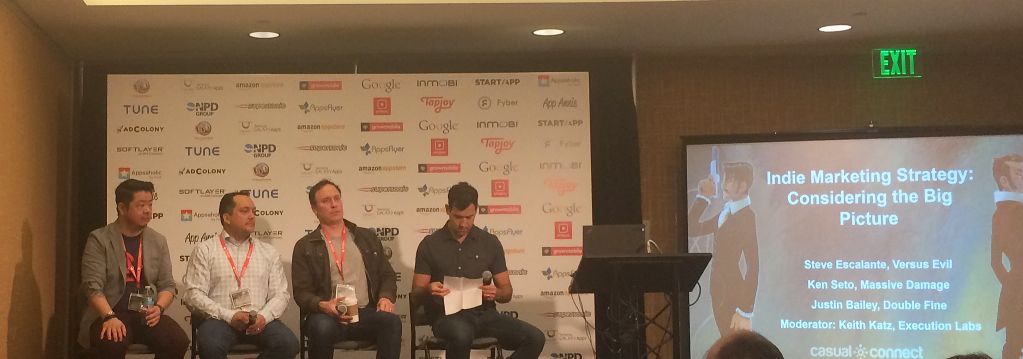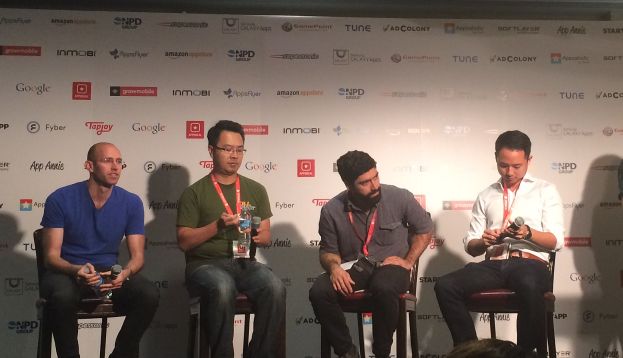Sessions at Casual Connect today brought together some experienced indie game marketers to address who small developers can gain awareness. Later, an experienced panel discussed best practices for game companies in navigating the $18 billion mobile advertising industry. Along with other sessions today, these sessions provided some seriously useful advice for companies large and small in how to market and advertise games in today’s difficult market.
Indie developers have proliferated with the opening of vast potential markets on PC and mobile platforms through digital distribution. Unfortunately, the downside of this grand market opening has been a corresponding difficulty in getting your game some attention in the marketplace. An experienced panel discussed some strategies that indie developers can use to get their games some love in the marketplace. Ken Seto of developer Massive Damage, Steve Escalante of publisher Versus Evil, COO Justin Bailey of Double Fine Productions, and moderator Keith Katz of developer Execution Labs (reading from left to right in the photograph below).
The panel discussed how games like The Banner Saga, published by Versus Evil, first appeared on PC and then later on mobile — and now Massive Damage is trying the same strategy. “The PC game I’m building is an experiment to see if it’s a path to the App Store, by establishing a brand and awareness on PC first,” said Seto. Escalante noted that they had done the same thing with Stoic’s The Banner Saga. “The conventional wisdom is to publish all versions at once, but this allowed us to engage with the press again,” Escalante said. “This gave us a whole new surge of press. Banner Saga was marketed as a trilogy, so we know we want to keep growing that base. For us that’s been a pretty good winning strategy. If you talk to the Stoic guys they’ll say they might have failed if they’d gone mobile first.”
The panel discussed the changing nature of Kickstarter and other crowdfunding sources, which have radically transformed over the past few years. “Kickstarter is much more of a pre-order engine now than a funding engine,” said Escalante, to the agreement of the other panelists. However, it’s a great marketing tool for indie developers even if getting your entire funding from it is very difficult. “Kickstarter is a platform to help you organize your community,” said Bailey.
The panel also discussed the rise in importance of influencers, which is especially critical for indies — who influencers often love to feature. “In the past we had a press list — now we have an influencer list, the influencer guys are very important,” said Escalante. “You need the Let’s Play and the YouTubers, it’s all those things put together. Make sure you’re targeting the right people. Target it — send it to the RPG guy or the shooter guy, know what they play otherwise it’s going to be noise to them.” That advice was aimed at indie developers, but it works equally well for large developers.

The larger developers got some advice targeted for them at the panel titled Navigating the $18B Mobile Ad Industry. Joining the panel were Spiros Christakopolous, senior manager of user acquisition at Sega; Kenneth Wong, senior monetization manager at Hothead Games; Adam Corrado, senior director of business development for Heyzap; and James Peng, head of mobile app acquisition at The Match Group (and recently head of user acquisition at Storm8). (The panelists can be seen in the photograph at the top of this article.) Moderator Corrado wondered how much control the panelists felt over the ads that were being shown in their games, and how much they felt they needed.
“You always want to have more control,” said Wong. “If your designer is not part of the process then it’s really hard. The more control you have, the more success you’ll find. It’s a struggle internally and externally.” Peng spoke about his experience at Storm8. “On one extreme you can just do direct deals and vet companies individually,” Peng said. “Or you can open up to everything. You have to decide where you want to be on that spectrum. At Storm8 we didn’t want to sell to direct game competitors. We vetted game companies individually, and whitelisted certain companies.” Christakopolous noted that Sega wants to make sure nothing objectionable is shown: ” For Sega we care very much about the experience of the user. We don’t show any casino games because we don’t feel our users would like that.”
Another big question for developers is whether to use commercial platforms for mobile ads, or to build their own in-house. The panel was quick to agree that usually it’s best to work with outside vendors. “When you build, it’s not done — it’s far from done,” Peng noted, saying that it only makes sense for the largest companies to build their own solution. “Is your scale large enough to merit building in-house For a King or a Supercell, it makes sense to keep the data there.” And Christakopolous agreed. “If you’re a developer you are better off trying to optimize your game rather than building an ad network,” he pointed out.
Brand advertisers are not in mobile games in a big way yet, with most of the advertisers in mobile games looking to get their own games installed. Still, the panelists can see the brand advertisers coming in the future. “The majority is coming from the CPI advertisers,” Christakopolous said. “We would love to see more brand guys. I think there are a couple of things that need to happen — on their side they need to get more familiar. On our side we need to add the specific targeting.” Those aren’t the only issues to consider when trying to attract brand advertisers. “It’s hard to get brand partnerships when your game is NC-17 and full of blood,” said Wong. The final word on brand advertisers came from Peng. “The brand dollars are coming, and they won’t be as uninformed as you think,” he said. When those brand advertisers come to mobile games in a big way, it’s going to be a major impact.

